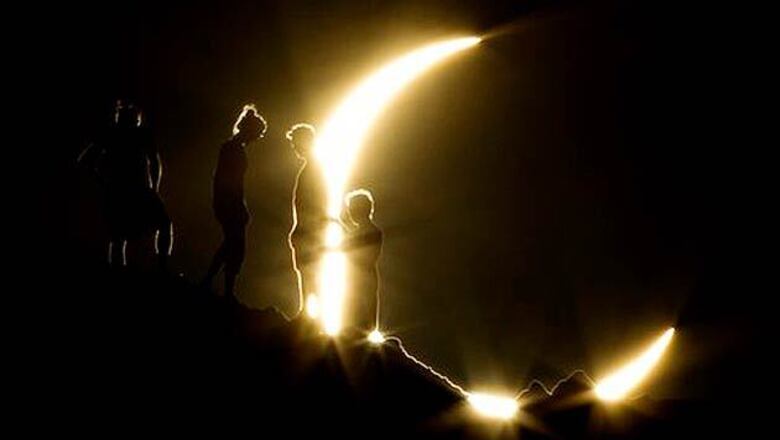
views
Kanarraville: The sun and moon aligned over the earth in a rare astronomical event on Sunday - an annular eclipse that dimmed the skies over parts of Asia and North America, briefly turning the sun into a blazing ring of fire.
Eclipses of some type occur almost every year, but stargazers have not seen an annular - shaped like a ring - eclipse on US soil since 1994, and the next one is not to occur until 2023. That is because the phenomenon requires a particular set of orbital dynamics, NASA Space Scientist Jeffrey Newmark said.
An annular eclipse occurs when the moon's orbit is at its furthest point from the Earth and closer to the much larger sun. That juxtaposition allows the moon to block more than 90 percent of the sun's rays when the two orbs slide into alignment.
"It's like moving your fist in front of your eyes," Newmark said. "You can block out the view of a whole mountain. It's the same kind of effect."
The eclipse was first visible over southern Asia and then moved across the Pacific. Traveling on diagonal path, the eclipse began its way across parts of Oregon, Nevada, Utah, Arizona and New Mexico, and was expected to disappear in Texas with the sunset.
Day did not turn into night. But light faded as the moon slid in front of the sun, much like turning down a dimmer switch, and then slowly returned as the moon moved away.
From start to finish, the eclipse was to be visible for just under two hours. A view of the so-called "ring of fire" spectacle at the eclipse's peak, however, was to last about four minutes, and even then was only visible to viewers positioned along the centerline of the eclipse's path.
Utah 'sweet spot' for viewing
In Utah, the "sweet spot" for viewing the full eclipse was Kanarraville, a community of just 355 residents about 230 miles south of Salt Lake City. Accessed by an old two-lane highway, the town has just has just two businesses - a campground and a nursery - plus a church, town hall and tiny post office.
Hours before the eclipse, a few thousand people gathered on a patch of dirt, sagebrush and cheatgrass in the town, setting up telescopes and enjoying picnics under sunshades.
"It's a little overwhelming. We're usually off the beaten path, but we're willing to open our town to all," an excited Town Clerk David Ence said.
A T-shirt salesman said his customers hailed from as far away as Brazil and Japan. Domestically, Edward and Jean Eadurka drove out from Virginia for the eclipse, after Ed's last attempt to see an annular eclipse, in 1994, was thwarted by cloud cover.
Jean said her 66-year-old husband is so enamored with the skies that he built himself a personal observatory - a backyard shed with a retractable rood - and often spends the whole night looking through his telescope.
"I'm an astronomy geek, I guess," said the retired court administrator, who once took an Atlantic Ocean cruise to see a solar eclipse. "I've been doing this so long it's compulsive."
Area officials said thousands more astro-tourists had been expected to attend so-called "star parties" at other locations across the region, including Zion National Park, Bryce Canyon National Park and Cedar Breaks National Monument.
Scientists cautioned eclipse viewers not to look directly at the sun, as doing so could damage the eyes, recommending astro-enthusiasts look at the eclipse through specially designed glasses or telescopes. Viewers could also use a cardboard box to make a pin-hole camera and project an image of the eclipse onto a piece of paper for safe viewing.
Despite the infrequent nature of an annular eclipse, it was part of the normal astronomical cycle, said Inese Ivans, an assistant professor of astronomy and astrophysics at the University of Utah. Still, she said it was bound to pique curiosities and inspire awe.
"It reminds us that the earth is spinning. That everything is constantly in motion," Ivans said. "This sort of gives you a chance to step out and remember ‘Oh yeah' there (is) a lot of stuff out there that we don't know anything about."


















Comments
0 comment